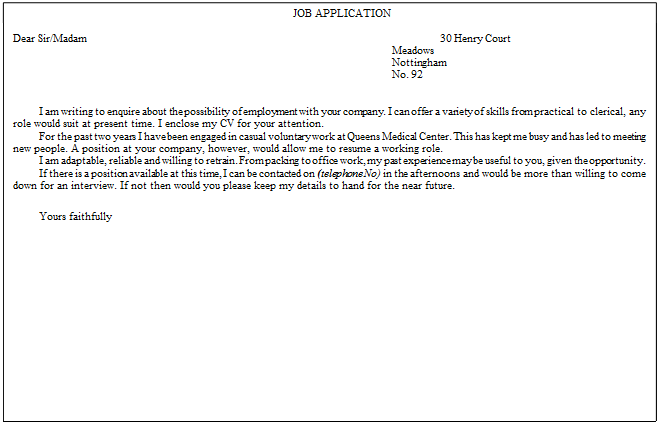VIII. Speak about applying for a job using these prompts
– employment agency
– job opportunity
– firm reputation
– free command of the language
– appropriate position
– job interview
– to write an effective resume
– educational and professional background
– the research on the company
– to send an application
– to stress your qualification for the vacancy
– to gain experience
– to stress your flexibility and readiness to learn.
Text B
APPLYING FOR A JOB
Time flies, and one day you will have to seek for the job. In this unit you will learn how to write a letter of job application, curriculum vitae (CV) – resume (American version), a short written account of your education and past employment.
Besides you'll be given some hints (advice) on how to behave during an interview.
How to write a job application
The job-winning tips given by some professionals:
1. Writing in black ink on white unlined paper looks professional. Put your address, telephone number and date in the top right-hand corner and the name of the person you are applying to on the left, level with the date. Write the company name and address below.
You can possibly type your letter but employers do prefer to see your
handwriting. Leave a line between paragraphs.
2. First paragraph – a polite one-sentence opening explanation why you are writing.
3. Tell them you know they are busy people but stress that your CV proves you are worth time too.
4. Describe yourself like a product on sale. List your skills and personal qualities like high motivation, enthusiasm and adaptability.
5. If you have qualifications, list them briefly.
6. Flattery is important, so explain why it's the only firm you want to work for.
7. Ask for an interview. Say you are happy to come in for a chat at any time, even if there are no jobs available now. Thank the reader for their time and remind them you are waiting for a reply. Use «Yours sincerely» if you're writing to a named person and «Faithfully» if you started «Dear Sir/Madam». Sign your letter at the bottom left and print your name clearly below.

CV (CURRICULUM VITАЕ)
Always type it on unlined white paper, preferably a single sheet.
Write your name, address and telephone number.
Put your health record, date of birth and marital status.
In the next section, note down your education. Put any qualifications on the next line.
Next, detail your work history, starting with your most recent job. Give dates and describe your duties.
List hobbies and interests and put extra information in a separate section.
End by saying that two referees are available on request – not naming them leaves you free to choose the best ones for particular jobs. Rememberthelonger an application, the less chance it has of being read.
Never send a photo-copied letter – it looks like you don't care.
Always be positive and never apologies for being You.

Text С
CV
Preparing for a job: CVs
| Your CV should be | • word-processed • laser printed on good quality paper • no longer than two pages of A4 paper |
You should include:
Personal details
The employer wants to know «who you are and how to contact you (essential informal only).
Education
3. Work experienceDon't just describe the job – stress what you achieved and what you learnt.